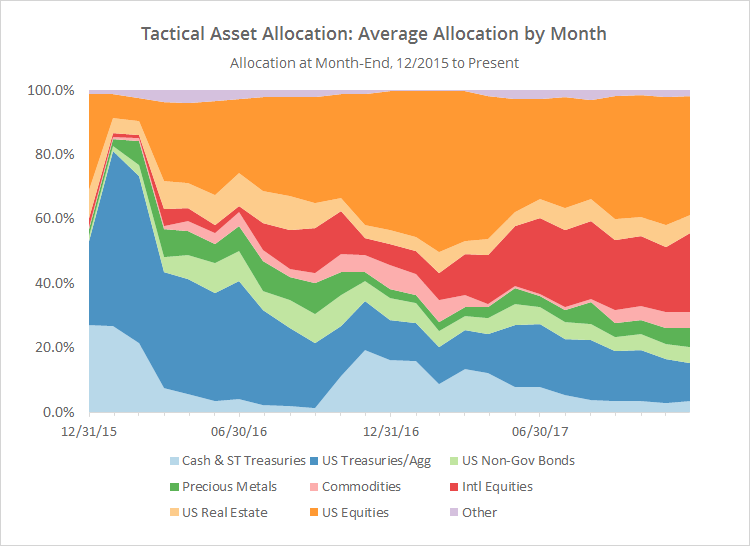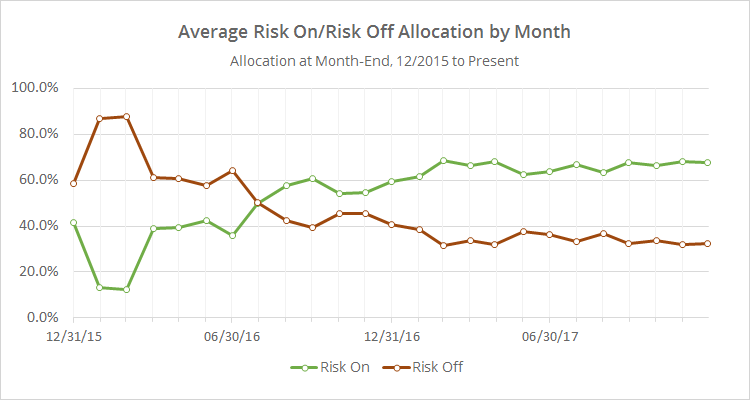Blogging was light in December. We spent the month working on the launch of a new fintech project that many of our readers will be excited about. We’ll be sharing details in the coming month and getting back to our regular blogging and site development schedule. — Allocate Smartly
This is a summary of the recent performance of a wide range of excellent tactical asset allocation strategies. These strategies are sourced from books, academic papers, and other publications. While we don’t (yet) include every published TAA model, these strategies are broadly representative of the TAA space. Learn more about what we do or let AllocateSmartly help you follow these strategies in near real-time.
Commentary:
 It was a strong month for tactical asset allocation. Like much of this year, it was hard to go horribly wrong, with most major asset classes up for the month. Notable winners included both offensive and defensive asset classes, ranging from emerging market equities (ex. EEM +3.76%) to commodities (DBC +2.78%) and gold (GLD +2.11%).
It was a strong month for tactical asset allocation. Like much of this year, it was hard to go horribly wrong, with most major asset classes up for the month. Notable winners included both offensive and defensive asset classes, ranging from emerging market equities (ex. EEM +3.76%) to commodities (DBC +2.78%) and gold (GLD +2.11%).
For the year, “Classical Asset Allocation” from Dr. Wouter Keller, Adam Butler and Ilya Kipnis earned the top spot. In terms of simply return, the “offensive” version of the strategy led the field at +26.7%, but in terms of return relative to historical volatility (likely a better judge of a strategy’s recent performance), the “defensive” version was the site’s top performer at +20.7%. That’s especially impressive for a strategy that has exhibited uber conservative historical volatility about a third less than the 60/40 benchmark.
Data Dump:
With such a large pool of published strategies to draw on (40 and counting), we’re able to draw some broad conclusions about the state of TAA. The following two charts help to show trends in the asset classes that TAA as a whole is allocating to over time. Members note that you can see this information updated daily with our Aggregate Asset Allocation report.
The first chart shows the average month-end allocation to categories of assets by all of the strategies that we track. For example, “US Equities” may include everything from the S&P 500 to individual stock market sectors. The important takeaways from this chart are essentially the same as they were for most of the year: TAA’s exposure to defensive assets like cash (light blue) and US Treasuries (dark blue) is at it’s lowest point since 2004, and exposure to international equities (red) is near it’s highest point since late 2005 (click for a longer view). TAA continues to be positioned very aggressively. That will become even clearer in the follow up charts.
In the second chart below, we’ve combined average TAA allocation into even broader categories: “risk on” (equities, real estate and high yield bonds) versus “risk off” (everything else). We realize that some asset classes don’t fit neatly into these buckets, but it makes for a useful high level view.
This chart shows that overall allocation to risk assets remains elevated. The last time TAA’s exposure to risk assets stood at these levels was way back in 2007, about 6 months prior to the onset of the Global Financial Crisis (click for a longer view). That’s a good thing if this broad rally continues, but it means that there remains significant exposure to investors here if the market stumbles in January.
We invite you to become a member for about a $1 a day, or take our platform for a test drive with a free limited membership. Put the industry’s best tactical asset allocation strategies to the test, combine them into your own custom portfolio, and then track them in near real-time. Have questions? Learn more about what we do, check out our FAQs or contact us.

